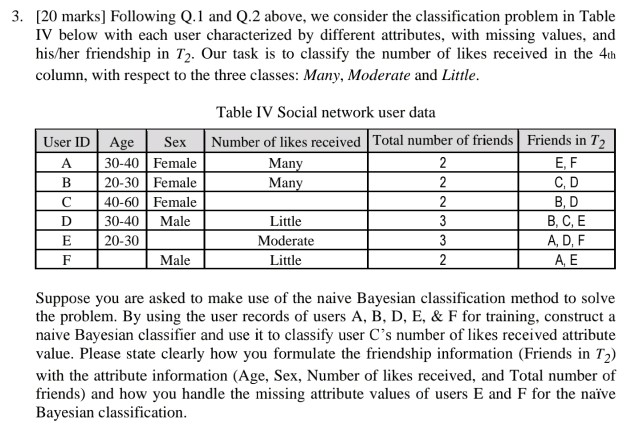Answered step by step
Verified Expert Solution
Question
1 Approved Answer
3. [20 marks] Following Q.1 and Q.2 above, we consider the classification problem in Table IV below with each user characterized by different attributes, with

3. [20 marks] Following Q.1 and Q.2 above, we consider the classification problem in Table IV below with each user characterized by different attributes, with missing values, and his/her friendship in T2. Our task is to classify the number of likes received in the 4th column, with respect to the three classes: Many, Moderate and Little. User ID A B Age Sex 30-40 Female 20-30 Female 40-60 Female 30-40 Male 20-30 Male Table IV Social network user data Number of likes received Total number of friends Friends in T2 Many 2 E, F Many 12 CD BD Little B, C, E Moderate 3 A, D, F Little 2 AE E F Suppose you are asked to make use of the naive Bayesian classification method to solve the problem. By using the user records of users A, B, D, E, & F for training, construct a naive Bayesian classifier and use it to classify user C's number of likes received attribute value. Please state clearly how you formulate the friendship information (Friends in T2) with the attribute information (Age, Sex, Number of likes received, and Total number of friends) and how you handle the missing attribute values of users E and F for the nave Bayesian classification. 3. [20 marks] Following Q.1 and Q.2 above, we consider the classification problem in Table IV below with each user characterized by different attributes, with missing values, and his/her friendship in T2. Our task is to classify the number of likes received in the 4th column, with respect to the three classes: Many, Moderate and Little. User ID A B Age Sex 30-40 Female 20-30 Female 40-60 Female 30-40 Male 20-30 Male Table IV Social network user data Number of likes received Total number of friends Friends in T2 Many 2 E, F Many 12 CD BD Little B, C, E Moderate 3 A, D, F Little 2 AE E F Suppose you are asked to make use of the naive Bayesian classification method to solve the problem. By using the user records of users A, B, D, E, & F for training, construct a naive Bayesian classifier and use it to classify user C's number of likes received attribute value. Please state clearly how you formulate the friendship information (Friends in T2) with the attribute information (Age, Sex, Number of likes received, and Total number of friends) and how you handle the missing attribute values of users E and F for the nave Bayesian classification
Step by Step Solution
There are 3 Steps involved in it
Step: 1

Get Instant Access to Expert-Tailored Solutions
See step-by-step solutions with expert insights and AI powered tools for academic success
Step: 2

Step: 3

Ace Your Homework with AI
Get the answers you need in no time with our AI-driven, step-by-step assistance
Get Started


